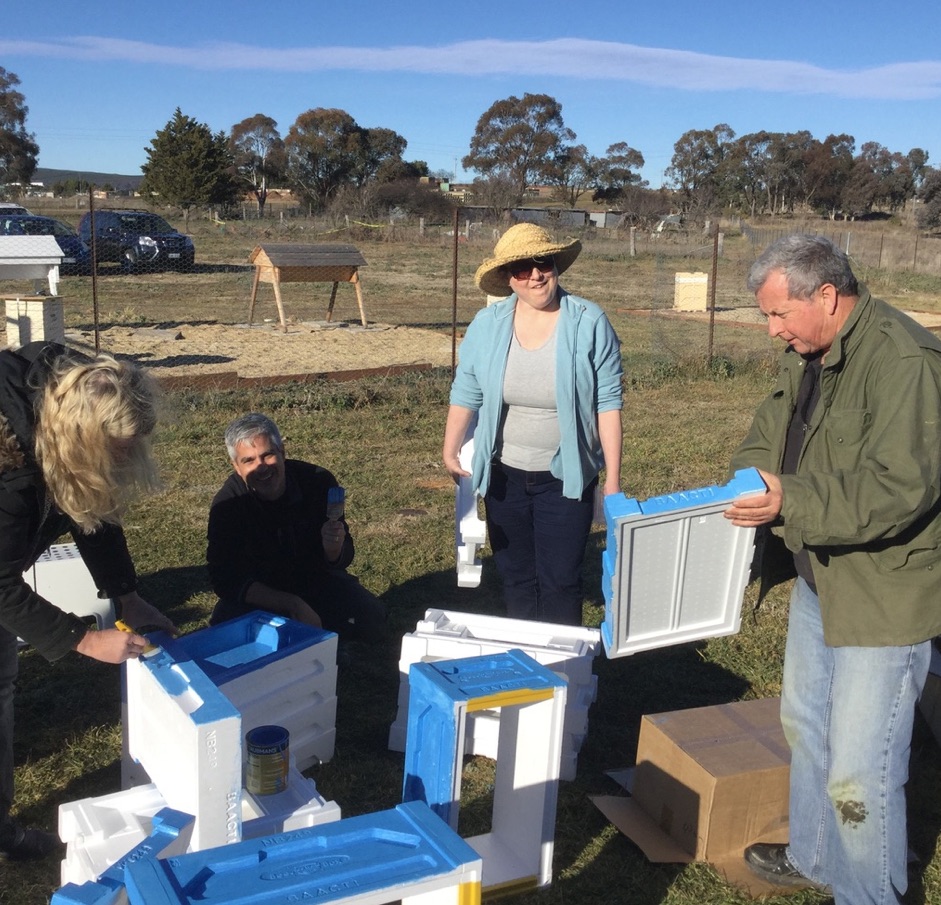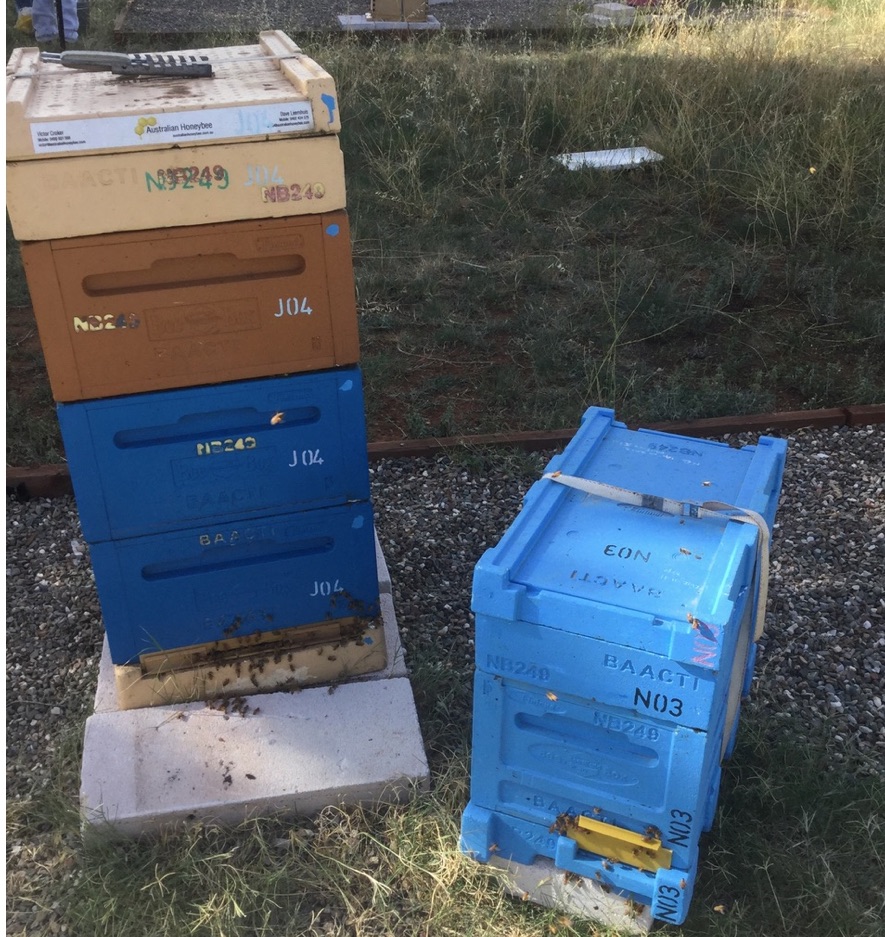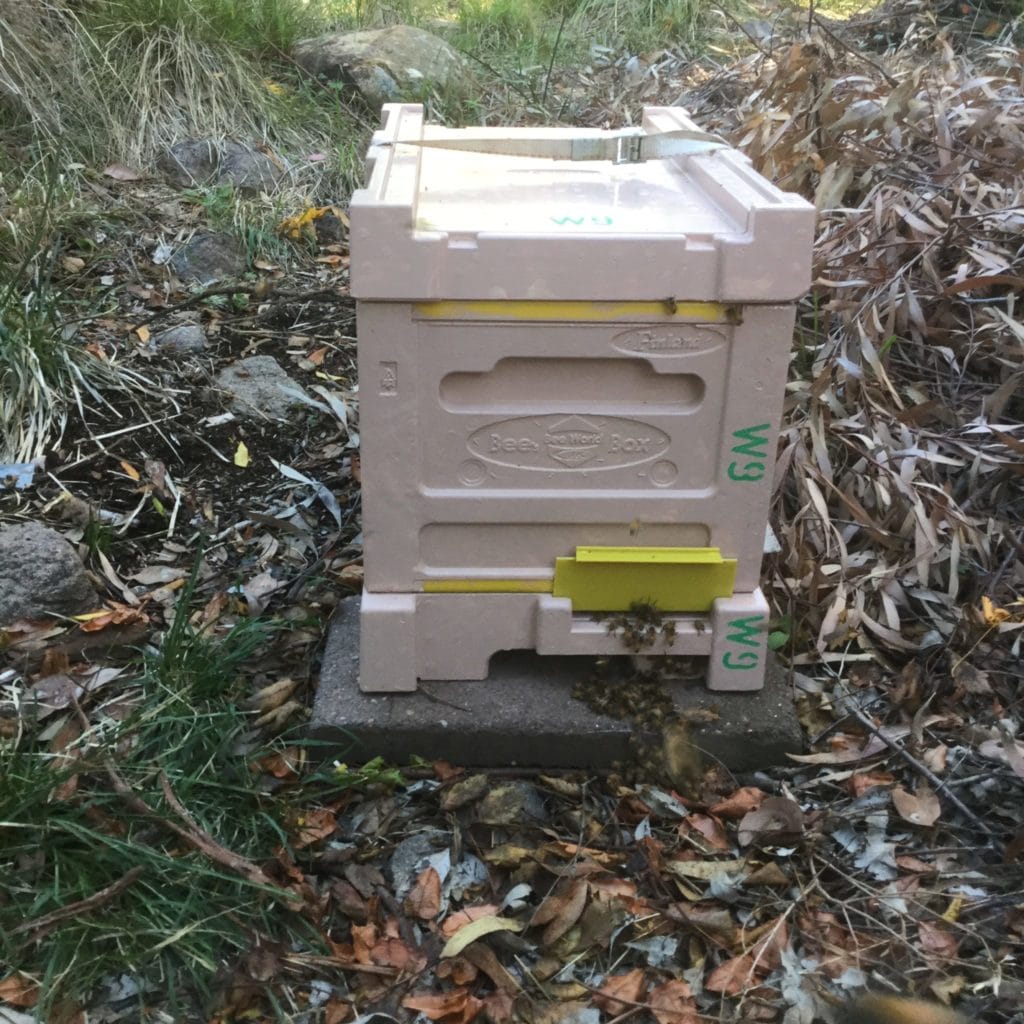
Bee Buzz Box – May 2019
Alan Wade
No, Bee Buzz Box is not trying to cast aspersions on your midriff. But everyone carries a spare in their boot. It is ready and inflated when your tyre picks up a nail while you are doing some retail therapy in Fyshwick. And you might want to carry at least two (and spare fuel – see last month’s Bee Buzz Box) as well as a repair kit when you head out along the Oodnadatta Track.
Well a spare nuc (a baby or nucleus hive) in any apiary can also be liquid gold when you consider either trading in the monetary value or enjoyment brought to you by your bees when all does not go according to Hoyle.

Hoyle 1762-1769: according to accepted standards or rules. The phrase refers to 17th-century British writer Edmond Hoyle, who wrote extensively on the rules of card games. According to Hoyle, this is the proper way to change a tire. Source: https://en.wikipedia.org/wiki/Edmond_Hoyle
In times past I just ran a handful, and occasionally too many, full strength hives with no such backup. Somewhere way back I then changed tack. I built a Swathmore Swarm Box, raked up about 30 nuc boxes and finally purchased a breeder queen and raised more queens than most beekeepers can poke a stick at. A little older and now somewhat wiser, these days I seek out commercial queen breeders with a good reputation and buy a few more queens than I need. Much simpler. Not only do I get gentle, productive queens, ones that have a good measure of disease resistance, but I get the spares I really need.
But queens still fail and I’ve had more than my fair share of failed introductions, something I put down to a poor understanding of the queen (or gyne) status of the colonies I have tried to requeen. So I keep two or three spare nucs and rarely directly requeen any large colony. These days I haul out the few nuc boxes I still posses, dust off the cobwebs and introduce queens I purchase to them – the nucs, not the spiders. Those nucs I make up a day or two before they arrive in the post to make sure the new girls are made instantly welcome, a practice a little reminiscent of preparing for that first date. Easier and less stressful than trying to find 20 queens in late season buildup conditions when the bees are spilling out of three supers.
The wisdom of carrying a spare tyre
Often enough any seasoned beekeeper is asked by a new starter: ‘How many beehives should I keep in my back yard?’ Many beekeepers only want to dabble and enjoy the acumen of actually owning a hive. Yet the advice proffered is almost invariably to get a second hive. However be extremely wary of owning three or more. Why so?
Well firstly honey bee colonies are about as variable as people and about as unreliable. Some are interesting, only some are productive and there is the ever constant risk of losing a good queen (or hive) and being in a quandary about how to find a replacement. The same applies to bees. Being on your own is a risky business.
The real value of having two hives is being able to compare their performance, one against the other. For the beginner, this can be of enormous value. It teaches you that a hive can perform beyond all expectations and it will teach the skill of ‘reading hives’, knowing exactly when bees are failing or below par. But owning ‘two instead of one’ has unparalleled merit when – as any beekeeper soon enough discovers – one queen falls over. Not surprising when you consider the risk a fly takes when that fly swat comes out and she knows there are no replacements to raise maggots in that meat left on the sink.
Instead of being (s)wiped out you can quickly establish a new colony by simply splitting the remaining healthy colony once it reaches double box strength. Or, if you just lose or squash a queen, the simple measure of swapping over a comb of young brood to the seemingly queenless colony will rectify the problem instantly. In both cases, the queenless split and the colony (to which young brood has been added) will immediately raise an emergency queen. She will take a bit over three weeks to first hatch, then grow, pupate, emerge, mate and start laying. So the bees will miss a brood cycle but, in beekeeping terms, the problem is solved.
In the back yard – assuming you regularly inspect your bees to check their disease status – the second hive is almost the best guarantee that you won’t be wiped off the beekeeping slate. That second colony, so to speak, is your spare tyre.
At a larger scale you may want a number of productive colonies and continually pinching frames of brood and tracking colony performance and potential for transferring disease from one hive to the next is a real possibility. Ask me? I once lost a whole backyard apiary to AFB and small hive beetle when my surveillance became inexplicably lax and I spread the problem around by interchanging gear.
A simple solution to keep all your full size gear in active service is to run spare nucs (one for around five hives, and an addition nuc for every 10 colonies thereafter). If you make them up from hives to be requeened (leaving the queen behind) the risk of transferring disease is minimised and the chance of successful queen acceptance is greatly increased. And as I have discussed elsewhere you buy time – the old queen does not need to be found – and you eliminate the chance of losing two queens – by first killing the old queen and then failing to establish the one you have just opened your wallet for as a replacement.
The spare tyre(s) are a great investment but there is the additional work of maintaining the nuc, giving the queen enough room to lay (by exchanging frames of sealed brood for empty combs in hives that need strengthening). However by running a spare you will always be in a position to resolve hive queen problems quickly without having to get on a long waiting list from an oversubscribed queen breeder.

A club nuc foray July 2017 when the club started to use them as the main way to requeen hives
And of owning three or more hives? Beekeeping can be infectious but beware of keeping more bees than you can sensibly manage. Too many hives will also test domestic alliances.
Nucs and swarming
The whole issue of requeening and issues such as swarming have been fully canvassed in club website blogs but whenever things go awry, one of resources you can always turn to is that spare tyre you have saved up for the rainy day. And if you think the extra queen is money down the drain, it’s worth remembering that a queen in a small colony won’t lay nearly as fast as the same queen in a full strength colony. She will have only a few thousand workers at most and they can only nurse a frame of two of bees. She ‘ages slowly’ just as diutinous (long lived overwintering bees) live much longer and only die when they have the stress of raising bees and foraging in early spring.
So when your bees are roaring and spilling out the front of the hive in spring, pulling out that nuc to requeen a colony headed up by an aging mum is one of the best ways – apart from providing bees more space – to head off swarming.

Nuc set up to requeen Paradise Colony J04, Jerrabomberra Wetlands mid January 2019
Nucs add a dimension to your apiary, are easy to inspect and manage and provide an entree into the skills of checking for disease and finding queens so much more challenging in a full strength hive.
My only recommendation is that you acquire an insulated high density polystyrene six-frame nuc if you want to successfully overwinter such a small colony.


A late call – moving a strong nuc from a wooden 6-frame nuc box to an insulated box May 2019
Need to buy that extra nuc gear?
Well when push comes to shove you don’t have to buy nucs or nuc gear. A regular full depth box will do. Just slip in a piece of corflute or heavy duty cardboard and move it across the box as the colony expands. And we really haven’t explored the many uses of nucs or some of their weird and wonderful designs. However there is nothing wrong with using standard gear to make up nucs – or you can make them from broccoli boxes by inserting dowel rods or bamboo sticks to rest frames on. The central function of nucs is to maintain spare queens that will greatly increase the flexibility in running any apiary.
But speaking of corflute don’t get caught pinching political signs at the edge of the road or, like the lass at a CWA rally out of Brisbane, you may end up with egg on your face.

Be the first to comment